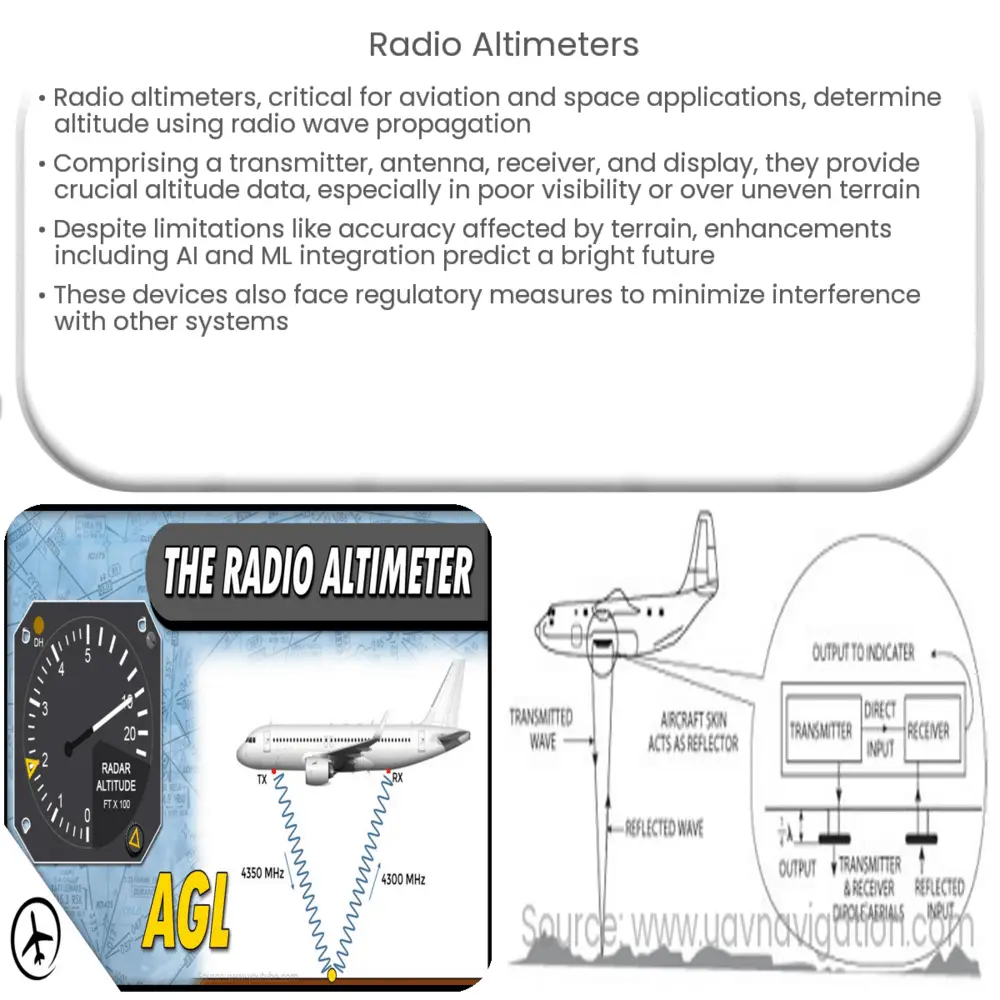Explore the fascinating world of radio altimeters, their operation, applications, and future advancements in aviation and beyond.

Understanding Radio Altimeters
Radio Altimeters, also known as Radar Altimeters, are crucial navigation devices used primarily in aviation and space applications. They provide essential altitude data by sending radio waves from an antenna mounted on the aircraft to the ground and then measuring the time it takes for the signal to return.
Working Principle
The operational principle behind radio altimeters is simple yet effective. It relies on the fundamental properties of radio wave propagation and the speed of light. A radio altimeter transmits a radio frequency signal towards the ground and receives the reflected signal. The time difference between transmission and reception is directly proportional to the altitude of the aircraft above ground level (AGL).
Components of a Radio Altimeter
A radio altimeter system typically consists of four main components: the transmitter, antenna, receiver, and display unit.
- The transmitter generates and sends out the radio frequency signal.
- The antenna is used to transmit the outgoing signal towards the ground and to capture the reflected signal.
- The receiver calculates the time difference between the transmission and reception of the signal.
- The display unit presents the calculated altitude to the pilot.
Applications of Radio Altimeters
Radio altimeters play a vital role in various applications where accurate altitude information is needed. In aviation, they are extensively used during takeoff and landing to ensure safe operation by providing precise altitude data. This data is especially valuable when visibility is poor or when flying over uneven terrain.
In addition to aviation, radio altimeters are also used in space exploration missions. Spacecraft equipped with radar altimeters are used to map the surface topography of planets and other celestial bodies. For example, the Mars Reconnaissance Orbiter uses a radar altimeter to create a detailed topographical map of Mars.
Moreover, in unmanned aerial vehicles (UAVs) and drones, radio altimeters play a crucial role. They assist in maintaining a safe and stable flight altitude, avoiding ground obstacles, and enabling accurate landing.
Limitations and Challenges
Despite their significant benefits, radio altimeters do have limitations. One such limitation is their accuracy, which can be affected by factors such as the type and condition of the terrain over which the aircraft is flying. Also, radio altimeters cannot measure the altitude above sea level, only above ground level, which can be a challenge in certain flight scenarios.
Evolution of Radio Altimeters
Since their inception, radio altimeters have undergone significant evolution to improve their accuracy and functionality. Modern systems incorporate advanced technologies such as frequency modulation and pulse compression techniques to increase their range and resolution.
Furthermore, the development of lightweight and compact altimeters has enabled their integration into smaller craft such as drones and UAVs. This progress has significantly expanded the application spectrum of radio altimeters beyond conventional aviation.
Interference and Regulatory Measures
Radio altimeters operate within a specific frequency band to minimize interference with other communication systems. However, with the increasing demand for radio spectrum resources, especially for wireless and 5G communication services, the risk of interference has grown.
To mitigate this issue, regulatory bodies worldwide, such as the Federal Communications Commission (FCC) in the United States and the International Telecommunication Union (ITU), have set strict regulations on the frequency bands used by radio altimeters. These bodies work to ensure that these vital navigation devices continue to operate safely and efficiently.
Future of Radio Altimeters
The future of radio altimeters appears promising with the advent of next-generation technologies. Research is being carried out to integrate Artificial Intelligence (AI) and Machine Learning (ML) into these devices. This advancement would allow for predictive capabilities, enhancing safety measures further.
Moreover, altimeters are expected to play a vital role in emerging areas like autonomous cars, where precise distance measurement is crucial.
Conclusion
In conclusion, radio altimeters are indispensable instruments in aviation and space exploration, contributing to safety and successful mission execution. Despite their limitations, their continuous evolution and advancements are likely to mitigate these issues and expand their applications.
With the integration of advanced technologies and strict regulatory measures, radio altimeters will continue to provide precise altitude data for a variety of vehicles, from traditional aircraft to autonomous vehicles and drones. The future certainly looks bright for these vital navigation devices.

